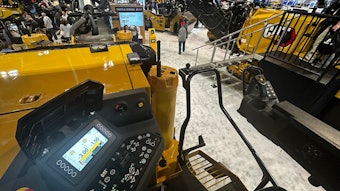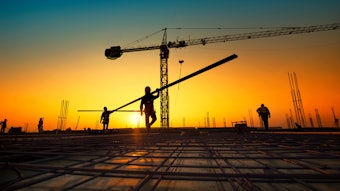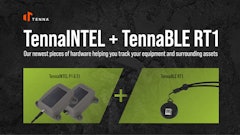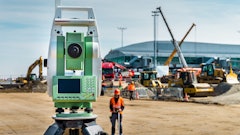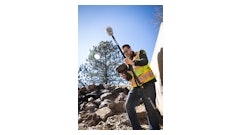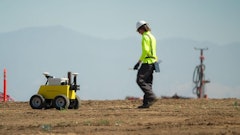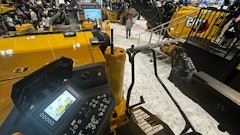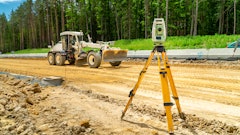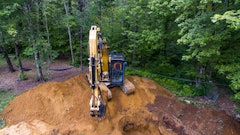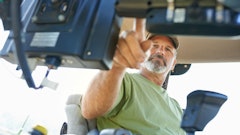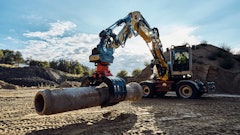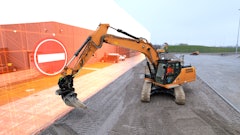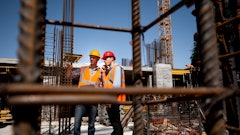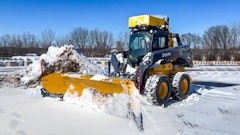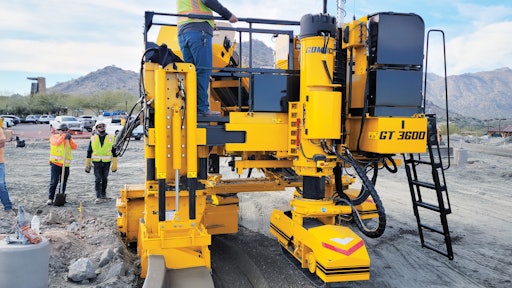
Machine control technologies range from 2D and 3D grade control to automation, robotic control, and augmented reality.
GPS/3D control – eliminating the need for placing stringline by hand – is becoming an industry norm, Stephen Bulluck, Power Curbers president, pointed out.
These technologies address challenges such as a shortage of qualified labor, an increased productivity demand to address the backlog in building or repairing infrastructure, and a need to increase profitability.
This story noted how GPS improves labor and resource allocation, how the strategic use of 3D-printed components improves site efficiency, and how its sensors yield more visibility into geography and structures.
These technologies offer the needed boosts in productivity and ROI as well as increased machine efficiency and safety.
The GOMACO company noted true 3D eliminates human error that can be involved with setting a physical stringline as 3D works from a digital model with a virtual stringline, a constant that cannot be physically changed.
Conventional stringlines are prone to displacement, as equipment or people can accidentally hit the lines, causing stringline movement and paving errors. Errors may come from the surveyor's grade control stakeouts, the company pointed out.
An Abundance of Machine Control in Concrete Work Options
“The development process for curb and gutter machines started in the early 2000s, paused during the Great Recession, and over the past five years has really gained momentum,” Bulluck said. “Even contractors who are not yet ready to invest in stringless control systems are ordering machines equipped GPS/3D ready.”
In 1999, GOMACO began paving with 3D on its equipment and the technology now used in grade trimming, curb and gutter tight radii, tunnel floors and walkways, airport runways and aprons, highways, interstates, concrete overlays, municipal projects, safety barriers, and golf cart paths, among other applications.
GOMACO works with Leica Geosystems, TOPCON Positioning Systems, and Trimble. GOMACO’s controls and programming software are designed to seamlessly interact with 3D. The 3D computer computes input from the total stations and prisms, compares that information to the project design model, and then outputs the elevation and steer commands to the GOMACO controller. 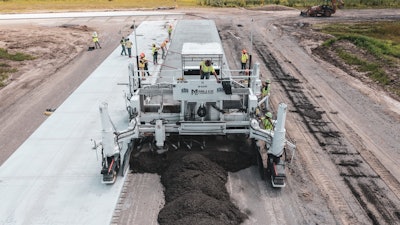 At Miller Formless, slipform pavers from small curb machines to the largest mainline pavers all utilize machine control.Miller Formless
At Miller Formless, slipform pavers from small curb machines to the largest mainline pavers all utilize machine control.Miller Formless
Sonic sensors are used on GOMACO texture/cure machines to eliminate the need for stringline on slipform paving projects.
More features continue to be integrated into the system. 3D can now be used to control the firing of an accessory like sidebar inserters and IDBI. Various stringless systems are also available for placer/spreaders and texture/cure machines.
“The use of total station GPS and augmented laser system in coordination with GPS gives you the accuracies of different levels,” noted Matthew Morrison, GOMACO’s 3D machine controls manager.
The type of sensor that will be used is dictated by the job. A plethora of different sensors may be used to obtain the right level of accuracy and cost association for a job such as city streets. In contrast, local governing specifications for accuracy in jobs such as highways and airports dictate what sensor will be used in conjunction with 3D machine control specifically for concrete paving, Morrison said.
“We use a combination of total stations, GPS, and laser augmentations to give them the benefits that would be pertinent to the job like a Walmart parking lot where there are 120 islands,” Morrison added. “For that, we would use a different system than we would use on an airport or a highway specification.”
At Miller Formless, slipform pavers from small curb machines to the largest mainline pavers all utilize machine control.
“For decades, the standard has been either analog-based or digital stringline control with proportional hydraulic systems,” noted Tod Smith, vice president of product and customer experience at Miller Formless.
“These systems automate grade and steering control to achieve a high-quality product within acceptable tolerance. In more recent years, there is a shift to integrate 3D control into the machine’s main control system.”
In these cases, the machines are all still capable of using stringline but can also run without string using robotic total stations and/or GPS, said Smith, adding that using 3D systems keeps jobs cleaner, helps decrease set-up time, and increases production.
GNSS technology such as Topcon's Millimeter GPS is designed to provide a complete system for concrete work. It utilizes satellite signals to determine precise positioning, enabling accurate placement of concrete for various applications like curbing, paving, and general concrete construction.
Laser technology offers vertical accuracy crucial for concrete work. Topcon's system employs a rotating laser to ensure precise elevation control, complementing GNSS for comprehensive accuracy in horizontal and vertical dimensions. The same laser can simultaneously control multiple machines, providing real-time elevation feedback to grade checkers.
Topcon integrates robotics systems into concrete paving processes, ensuring uninterrupted and precise data delivery to control systems. These systems can communicate with multiple robotic total stations, providing sub-centimeter accuracy crucial for complex paving projects. 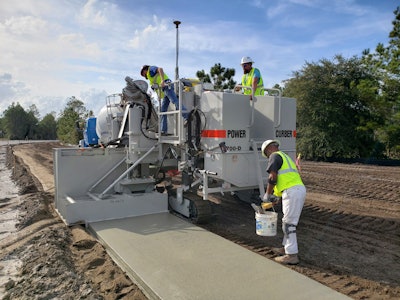 Power Curbers has worked with machine control suppliers to make the interface easy.Power Curber
Power Curbers has worked with machine control suppliers to make the interface easy.Power Curber
“Contractors can benefit from a combination of GNSS, laser-based, and robotics systems tailored to their specific project requirements and environmental conditions,” said Brian Lingobardo, senior director of intelligent paving business development at Topcon Positioning Systems. “This versatility ensures adaptability across various concrete construction applications.”
Machine Control in Concrete Work Yields Significant Benefits
Mobility
“Previously, the way we would do a job is we would have to set string line that would become a physical barricade to other applications trying to do work within that zone,” Morrison pointed out.
Mobility is the biggest benefit from using machine control, he noted.
It is easier to pave in tight clearance conditions because extra room for stringline is not needed and the contractor has the ability to pave anywhere on the project at any time. Not only does 3D increase flexibility but it also is designed to improve jobsite logistics such as not having to work around or be limited by stringline.
“If something is not ready, you can hop to another area and do not have to wait to do any stringline installation. You have a free open site where you can wander out and accomplish any task at hand,” said Morrison, adding that level of mobility makes the ROI “almost incalculable.”
Machine control removes the numerous human errors that come into play by setting up, measuring, setting a pin, and keeping the stringline “picture perfect” until the day it is time to pour, Morrison said.
“Between Mother Nature and all the other things indicative of a job site from other machines to wildlife and children, it becomes very difficult to maintain,” he added.
“The ability to take something that somebody has drawn in a CADWorx file and implement it directly onto the ground within the specification given is definitely a huge benefit. There is no interpolation,” said Morrison.
Time Savings
“For us to come off of a truck and take five minutes to set up our 3D to go to work versus a couple of days to string a machine job site to be ready to go ahead and drop the machine is time savings in a large abundance,” said Morrison.
The reduction in labor needs is the biggest driver for most contractors moving to machine control, Bulluck said.
“Setting stringline is laborious and requires expensive person-hours,” he added. “Contractors are excited to reduce crew sizes and eliminate physically demanding stringline setting. “
Bulluck noted one of his company’s end users told him ‘I couldn’t care less about stringless controls, but I can’t find anyone to pound pins anymore.’
“A secondary benefit and one that surprised us was how much machine control opens up the jobsite, especially in tight parking lots,” said Bulluck. “Elimination of stringline gives flexibility to concrete trucks, improving flow on the site and allows for other construction machinery to move more freely.”
Concrete Placement Accuracy
“Setting stringline by hand creates imperfection due to human hands adjusting the line and judging what’s acceptable,” said Bulluck. “The accuracy with which GPS/3D systems can control the machine is remarkable.”
Machine control is a necessity to keep the product in proper tolerance, Smith noted.
By eliminating the need for traditional stringline and staking, machine control streamlines the construction process, said Lingobardo. 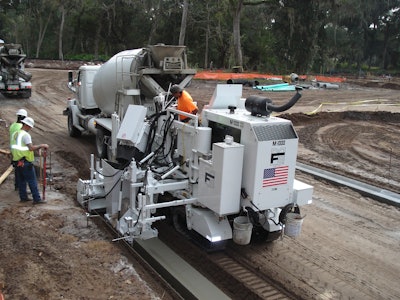 The machines are capable of using stringline but can also run without string using robotic total stations and/or GPS, and using 3D systems keeps jobs cleaner, helps decrease set-up time, and increases production.Miller Formless
The machines are capable of using stringline but can also run without string using robotic total stations and/or GPS, and using 3D systems keeps jobs cleaner, helps decrease set-up time, and increases production.Miller Formless
“Contractors can work more efficiently, saving time and resources while maintaining accuracy,” he said. “Machine control technologies also offer unmatched precision, enhancing the accuracy of concrete placement. This precision is essential for achieving desired grades and smoothness in concrete surfaces.”
This optimization reduces material wastage, contributing to cost savings for contractors, Lingobardo said, adding that machine control minimizes the likelihood of errors during concrete placement, preventing the need for rework.
“Contractors can achieve desired specifications on the first attempt, saving both time and resources,” he said.
Machine control technologies offer flexibility and adaptability in navigating tight paving corridors or overcoming obstacles on construction sites, Lingobardo noted, adding that contractors can adjust and adapt to challenging environments without compromising accuracy or efficiency.
Machine Control Automates Curb and Gutter Work With Accuracy
Power Curbers has worked with machine control suppliers to make the interface easy, Bulluck noted.
“Machine operators use an easy-to-read screen with a virtual map to track the machine throughout the job,” he added. “Between numerical data and the map display, the operator knows exactly where the concrete is going relative to the model. A crew member also can recheck the concrete’s location using a rover as concrete slips out of the mold.”
“Without string, you would need to use a separate 3D system such as Leica, Topcon, or Trimble,” said Smith.
“It can also provide contractors with better, more efficient results when working with complex designs and radius work,” Lingobardo said. “Topcon's LPS paver system facilitates uninterrupted data communication to control systems, ensuring accurate placement of curbs and gutters without the constraints of traditional methods.”
Contractors can navigate tight paving corridors or work around obstacles with ease using Topcon’s machine control technologies, ensuring accuracy and efficiency in curbing applications, Lingobardo said.
GOMACO has methods of teaching and mentoring contractors on how to automate curbs and gutters without strings to ensure accuracy, Morrison noted. 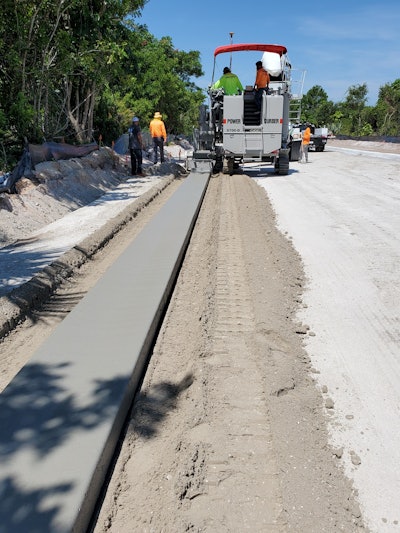 Power Curbers has worked with machine control suppliers to make the interface easy.Power Curber
Power Curbers has worked with machine control suppliers to make the interface easy.Power Curber
Machine Control Prevents Rework
Machine control technologies provide precise grade and steering control, minimizing errors during concrete placement. Contractors can achieve desired specifications with high accuracy, reducing the need for costly rework.
A CAD design file received before a contractor steps out onto the jobsite ensures checks and balances before the paving job is initiated.
“We know that our control is tight,” Morrison said. “We also verify the model ties into all existing structures. We know what our subgrade looks like because we've as-built it and we know that our grade is within a tolerance.”
“For us to keep our yield – our controlled elevation height versus how much concrete we put on the ground – … as tight as we want to is indicative that we do all those little steps to make sure we control it to the best of our ability.”
Morrison noted, “The data is the most important thing when it comes to any style of machines, whether it is concrete or earthworks. The tighter the specification, the more robust you need to be on your data preparation, your modeling characteristics and completely understanding what you are up against before you take that system and put it in the field. The fieldwork is going through the motions of using these things and going through the production on the daily data.”
Topcon's systems offer real-time feedback to operators and grade checkers, enabling immediate adjustments to ensure proper concrete placement, Lingobardo noted, adding this proactive approach helps prevent errors before they escalate, avoiding rework scenarios.
“By eliminating the reliance on stringline and staking, machine control streamlines the construction process,” he said. “Contractors can work more efficiently and effectively, reducing the likelihood of mistakes that lead to rework.”
Smith concurred, saying that having that exact location with machine control also enables the contractor to check behind the machine to ensure the placement is correct. 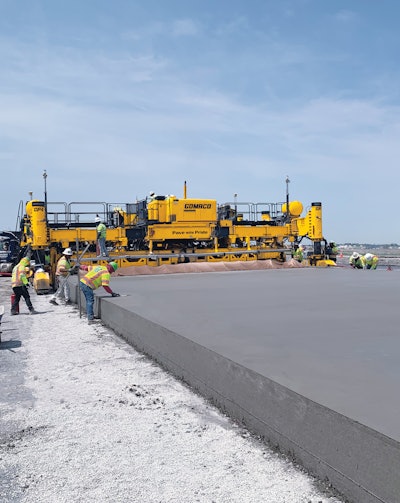 The GOMACO company noted true 3D eliminates human error that can be involved with setting a physical stringline as 3D works from a digital model with a virtual stringline, a constant that cannot be physically changed.GOMACO
The GOMACO company noted true 3D eliminates human error that can be involved with setting a physical stringline as 3D works from a digital model with a virtual stringline, a constant that cannot be physically changed.GOMACO
The technology also levels the playing field for workers no matter what their experience, Morrison noted.
“A lot of our machines are smart machines. A smart machine knows where all its appendages are and where all of its accessories are so then it can control them properly in coordination with the model it is given,” said Morrison.
Using the 3D machine control in the field is “quite easy to do on a daily process,” he added. “The things to focus on are the quality of the models, the data we get from the engineers, and the quality assurance and checks we do in the office prior to mobilizing to the machine in the field.”
It is critical to use technology in such a way that it performs as intended.
GOMACO noted signal loss can be caused by obstacles between the line of sight of the total station and the prism on the paver, such as trucks or workers as well as fog or areas with poor quality. Strategically placing total stations can lessen or eliminate fog or sun glare effects.
It is also important total stations are not set up on windy days where wind may hit them broadside, to anchor the tripods well and position them at closer intervals.
Leica has the auto-target recognition (ATR) lock threshold that monitors the quality of the ATR's prism following, ensuring the prism is reliably locked onto and tracked to help prevent inaccuracy potentially caused by high winds pushing or vibrating the total stations, fog, dust, or heavy rain.
The dual-axis compensator acts as a level, ensuring total stations have not been shaken out of level or knocked over by wind or something else.
If a total station is up to 0.1 degrees off vertical, it will compensate automatically in the measurements for that inaccuracy.
User Friendly
A key machine control benefit: it is user-friendly and helps level the playing field in the workforce where workers may have various levels of experience.
“In today’s environment, most machines have a level of automation on to them from the factory anyway. Dozers, graders, excavators – all of the things they use in the survey field plays into how easy it is for them to move into stringless on the concrete side,” Morrison pointed out. “All of that plays into how easy it is going to be for them to move into stringless on the concrete side.”
Morrison notes technology integration has produced “amazing” benefits.
“When I first started doing this a long time ago, it was just focused on 3D making the machine go up, down, left, and right,” he said.
Machine control has expanded to automate a significant number of processes in the work of concrete applications.
“It is less hassle for you to think about, so in all of the applications that come along with concrete paving, the big benefit is the integration into all these accessories that you're able to run,” Morrison said.




